
16 Oct 2020 HYN Himalayan Yoga Academy
YOGIC BANDHA AND SPIRITUAL IMPORTANCE- PART I
Yoga is a state of equanimity achieved through different means of yogic practice, from the beginning level to higher levels. Shatakarma, Sukshma Vyaayaama, Surya Namaskar, Asanas, Svasa kriya are foundations of yogic sadhhana, and some of the asanas, Pranayama, Mudras, Bandha, Yoga nidra are overall external (Bahyantar) to internal (Abhyaantara) means of yogic practices. Among these, bandha is associated with Asanas, pranayams, and Mudras practices.
What is Bandha?
The Yogic practices that lead to the activation of energy in certain specific parts of the body, with the help of the contraction of some muscle fibers that accelerate the functions of all organs attached to that area.
A bandha is a lock or hold in yoga, which is performed in order to direct and regulate the flow of prana/ vitality to certain zones of the body and mind.
Why Bandha?
Also referred to as an energetic lock, bandha was practiced by yogis of the past to promote energy flow and maintain optimal spiritual growth. Bandha may also be called “energetic seal” by modern practitioners. In Hatha Yoga, Bandhas are practiced to binds our Chitta (more about the mind in common sense), which eventually helps one into the spiritual path. Hatha yoga has taught this in the form of Bandhas which redirects the energy back to our body.
In yoga, the study of body & mind stands on the concept of energy that lies in our body in the form of Prana Shakti. The initial aim of all yoga practice is to get control over this Prana Shakti & this is where we need some practices called, Bandhas. Practicing bandha involves concentrated muscular contractions. Performing these locks can aid the practitioner in improving their focus and supporting physical health.
Importance of Bandhas in Yoga
We release the Prana through certain doors (openings) within our body. These doors are root/moola (pelvic area), navel (abdominal area), and throat.
A yogi’s aim of performing bandhas is to lock the energy within the central energy channel (Sushumna Nadi), which is considered an obstacle-free path of flowing energy.
Bandhas lock these doorways so that Pranic energy doesn’t leak unnecessarily into the atmosphere.
Usually, some areas of our body are energy-rich & some are energy-deprived. In energy-rich areas, Prana is actually get stuck by muscular tension. Bandhas redirects this stuck energy to the energy-deprived regions.
Bandhas are great tools to get control over different koshas of the body, firstly through physical means, then with just mental thinking.
As the bandhas are very helpful in the stimulation of the chakras, therefore, Yogis perform Bandhas for Kundalini awakening.
Types of Bandhas
Commonly, we hear about only four types of Yoga bandhas, but there are six types of Bandhas in Hatha Yoga, 2 minor, 3 major & 1 maha bandha.

1. Minor Bandhas
These are performed by locking our hand & feet area.
Hasta Bandha – Hand locks
Pada Bandha – Feet locks
Shiro-bandha- head Locks
2. Major Bandhas & Maha bandha
These are performed by locking muscles near to pelvis, abdomen & throat respectively.
The four bandhas are described as follows: Moola, Uddiyana, Jalandhara and Maha. Each bandha is associated with a major energy channel and performance of a particular bandha will influence the flow of prana to that channel.
Minor Bandhas
1. Hasta Bandha – hand locks
As the name suggests, Hasta Bandha means “hand lock”. This bandha locks the prana in the hand and arms. Besides, this Bandha awakens the energy channels up the arm. Hasta bandha builds strength for the Yoga Asana such as Adho Mukha Swanasana, Bakasana, and handstand.
How to Do
Place both your hands on the Yoga mat and spread all the fingers.
Start bringing some weight to the hands.
Press strongly the underside of knuckles to the mat. Also, press the finger pads and inner edge of the thumb into the mat. Bring all the pressure in these areas of the hand.
Leave the heals of the hands light. You will feel them lifted and there will be suction in the center of the palm.
Benefits of Yogic Bandha
Increases the strength and even flow of prana in the arms and hands.
Relieves the pain or discomfort in the wrist while performing a handstand, Purvottanasana, Chakrasana, tabletop pose, Bakasana Adho Mukha Swanasana.
2. Pada Bandha
Pada bandha – foot lock
The word Pada means foot. Pada bandha locks energy in our feet and activates the arches of the feet. This bandha provides stability and balance in Yoga practice.
This lock binds us with the Earth’s energy and helps to channelize the prana at the feet. It supports the elevation of joints in the legs and pelvic area.
How to Do Yogic Bandha
Place your feet on a yoga mat.
Now, lift all your toes and spread them out.
There are three arches in our feet. One from big toe to little toe, second, from the little toe to ankle, and third, ankle to the big toe
These arches form a triangle and they are griped.
Now, try to distribute your weight evenly among 3 arches of the foot and feel the pressure equally.
You can also place a ball under your foot.
Benefits of Yogic Bandha
Supports elevation in knees and pelvis, and connects Yogi’s body with the earth zone.
It provides balance and centeredness in Yoga practice.
Tones the organs of the lower body.

3. Shiro-bandha- head Locks
Stand on head by hand supporting on the floor, i.e., Shirasasana. It is King Asana, but it is not permitted for beginners, and some cardio and neuro problems.
To be continued…..
